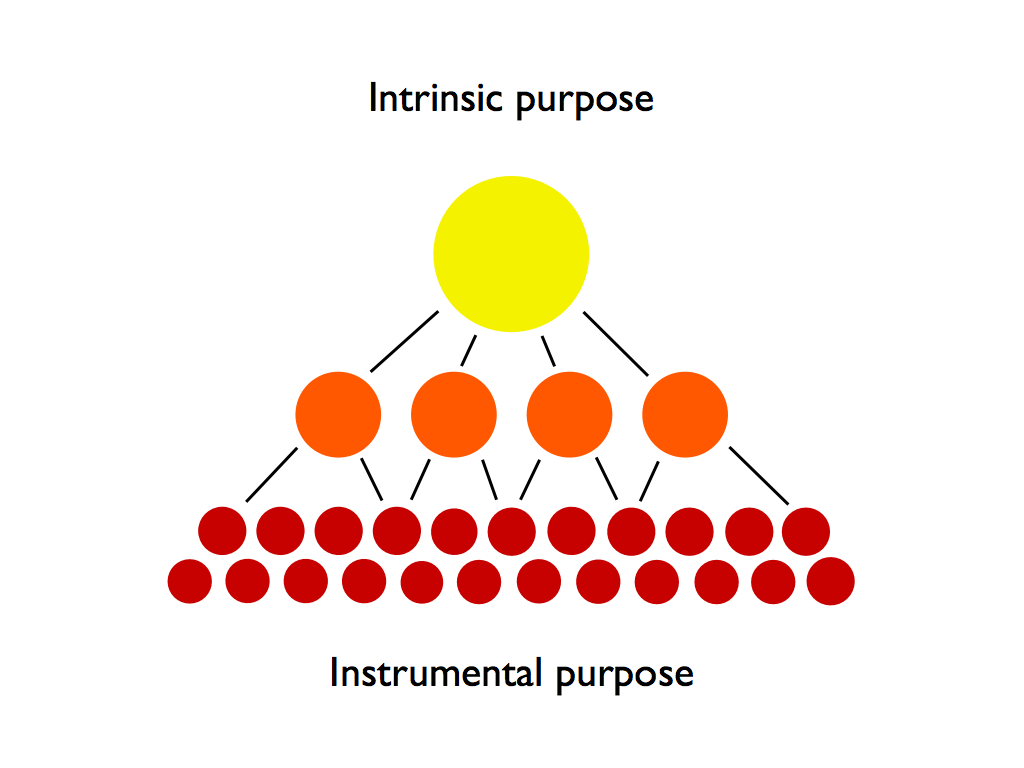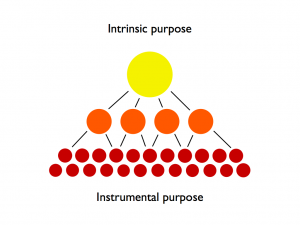 Over the holidays, my neighbour Bob told me about the January Minimalist Challenge he and his family are taking on to remove from their home the things they don’t need. On January 1, one thing goes. On January 2, two things. On January 3, three things, all the way to 31 things on January 31, for a grand total of 496. Continue reading The target is not the direction
Over the holidays, my neighbour Bob told me about the January Minimalist Challenge he and his family are taking on to remove from their home the things they don’t need. On January 1, one thing goes. On January 2, two things. On January 3, three things, all the way to 31 things on January 31, for a grand total of 496. Continue reading The target is not the direction
Category: Destination Alive or Adrift
Experiential strengthening
This is destination as articulated by a group of municipal employees I worked with this week. They are carving out a new way of being in their work, and their lives – their civic practice. Experiential strengthening…
Let’s synergize leverage opportunities to analyze, connect silos, information, platforms, initiatives into corridors of power pursuing overlapping goals expanding conduits shocking access beyond the usual suspects there’s so much to see when open supportive thoughtful innovative we are resource full experientially strengthening springboards for collaboration
Destination and emergence
Over the course of the last nine months, I have been sharing bits of the book I am working on – Nest City: The Human Drive the Thrive in Cities. I made a decision to share the book on my blog while I was working on it. Five chapters and 126 posts later, the decision to share this work before it is officially in book form is one I revisit over and over in my mind.
For each post to appear on my blog, I have to hit this button:
The word ‘publish’ is rather official. A recent author acquaintance of mine cringed when she heard I was sharing what I was working on: “Why are you giving this away?” Another author friend says, “Good for you. I blogged most of my book before it turned into a book too.” Others have warned me that publishers will not look at the book now that it has been ‘published’. I am of the opinion, still, that writing here is serving me and my readers well in several ways:
- I learn in bite-size pieces. I get to dive into small passages and sort and sift around in my being to seek out what I am learning.
- I write in bite-size pieces. These are small pieces that serve to help me wrap myself around a thought. Blogging helps me discern the pieces I have to work with, that will later shape up into book form. This is essential time to practice the craft of writing.
- We find each other. By sharing the pieces of my exploration, fellow explorers and I are able to find each other. As I share, I reveal myself to my audience, and my audience reveals itself to me.
- We build supportive relationships. I am receiving feedback from readers: the odd comment here on my blog, an email, a ‘like’ or comment in facebook or Linked In, or new followers on Twitter. I am hearing about how my writing supports others and the work they do. In return, readers are supporting me too by using my blog posts on their webs sites, as they teach, and simply by giving me feedback on what resonates for them.
- We grow our understanding – of selves and cities. The more we explore individually and collectively, the more we learn and improve. We are expanding our consciousness.
I don’t know – yet – what my writing will add up to. I do know that my writing, when published as a book, will not read as it does here. While I have a destination in mind – a published book that we can lay our hands on physically and digitally – I do not know exactly what it will say and how it will say it. I have a frame that I am using here, with chapters and the like, but I an open to that changing if and when that makes sense. With each post, my sense of direction gets more clear. Even what the book will say gets more clear. But the real book to come is in the process of emerging.
The very process by which we create our cities, through the interplay of destination (chapter 4), a learning journey (chapter 5) and emergence (chapter 6), is in play for me as I craft the book. I have a destination/direction; I am on a learning journey; I am about to explore the thresholds that each of us, and our cities come across as we emerge.
The next series of posts will explore the role of emerging thresholds as we organize ourselves and our cities for continuous improvement.
_____ _____ _____
- My decision to share the book while I am working on it
- The overall structure of Nest City, is in three parts
- The plot for Part 2, chapters 4-7
Destination both alive AND adrift
The last series of posts explored the role of destination as we organize ourselves – and our city habitat – for continuous improvement. In Destination alive or adrift, I proposed to cover the role of ‘purpose’ in a city, what makes a city alive, how we can tell when we are adrift, and the connection between individual work and city purpose. All of this to reveal why our work matters.
Cities are alive with purpose. Higher order purposes give us something to latch onto, allowing us to focus, learn and choose. Higher order purposes are not precisely planned, but we do have an opportunity to shape them because the purpose of evolution is evolving. We are moved to improve our conditions and this takes place in a self-other dialectic; we pursue self-improvement and give to the wider community at the same time. This is the evolutionary influence at work. Evolution has a purpose that is co-created by the agency of humanity.
This evolutionary impulse is alive and adrift. It is very alive in each of us, and the collectives of which we are each part, yet since we don’t know the purpose of evolution, which is itself evolving, things are also adrift. As Steve McIntosh put it, evolution “cannot be discerned with finality because it is still in the process of being determined by the beings whose choices are required for its creation (p. 161).” The highest order purpose, or destination, can not quite be defined because it is alive.
The city’s purpose, as it is for each of us, is survival and improvement. At every turn, we aim to survive and improve (see 100 urban trends), which adds up to our continuous attraction to move “toward more complex forms of social organization (McIntosh, p. 146).” Our impulse to thrive in cities is alive and well, and the result is a nest of city purposes (Figures A and B), at every scale (from individual, to city/region, to planet):

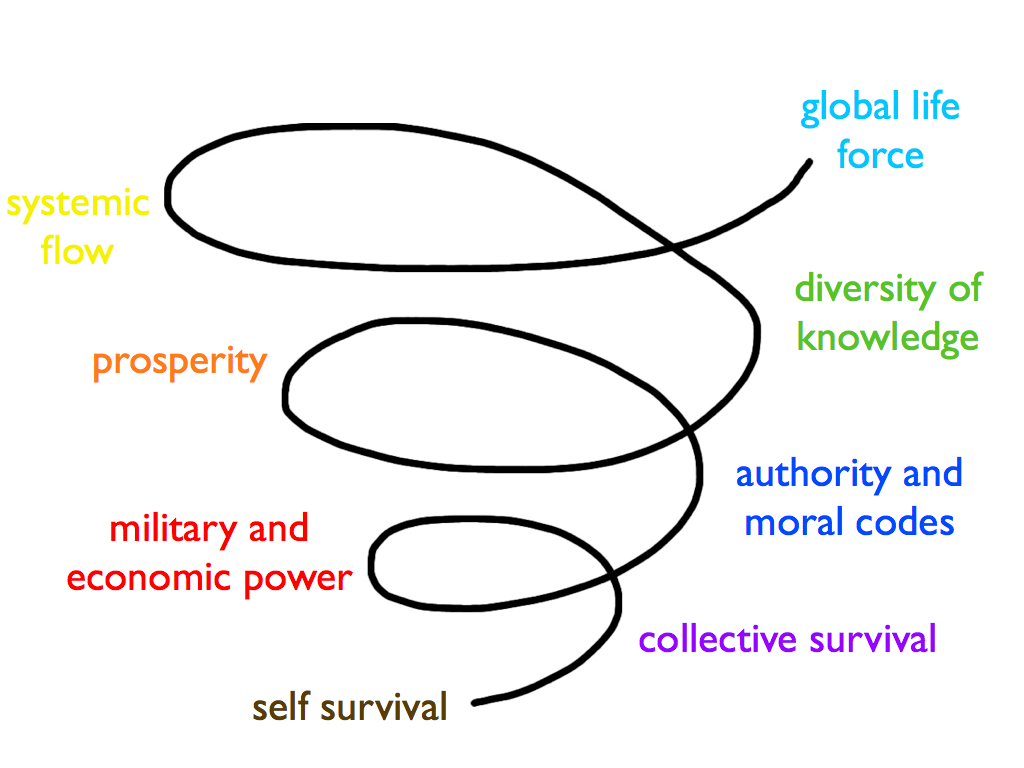
Our short-term destinations and our bigger destinations are connected, with each of us, between each of us, and between each of us and the larger collective. There are scales of purpose in the purposes themselves and the scales of our social organization. The small is connected to the small – and the large.
As we discern that the city’s destination is our own evolving purposes, it necessitates looking at our role – and purpose – in the city. To use Steve McIntosh’s language, each citizen, as a whole evolutionary entity, has intrinsic value. Citizens have value both as a whole, and as a fundamental part of something larger. As a part, it is instrumental. Citizens are of instrumental value to the intrinsic value of the city created by us. Instrumental and intrinsic purposes are evident at scale. The intrinsic value of each citizen is instrumental to the city.
How we show up as citizens, showing up for our quest for survival and continuous improvement, for both self and others, is critical. If I don’t show up, then I affect my personal ability to survive and continuously improve as well as my city’s ability to do the same. Self and the city are only as good as we make them. Everything we do matters. Our cities are as good as we make them.
Destination is simultaneously alive and adrift. It is most alive when we work from our passion, our inner drive to improve. When we catch glimpses of bigger destinations, for both self and the city, our direction, through short-term destinations, is discerned for fleeting moments. Between these fleeting moments, we feel adrift, which is to feel alive.
What is your intrinsic value?
How are you instrumental to your city?
_____ _____ _____
This post forms part of Chapter 5 – Destination Alive or Adrift, of Nest City: The Human Drive to Thrive in Cities. Click here for an overview of Chapters 4-7 (Part 2 – Organizing for Emergence). Click here for an overview of the three parts of Nest City.
_____ _____ _____
Further reading…
McIntosh, Steve. Evolution’s Purpose: An Integral Interpretation of the Scientific Story of Our Origins
Purpose – planned and not planned
‘Purpose’ has some sort of connection with ‘destination’. Why would you go anywhere without a purpose in mind? Why go to the trouble?
While exploring instrumental and intrinsic purposes in the macro evolution of the human species, based on Steve McIntosh’s work, I realized that citizens are instrumental to the intrinsic city. As I connect this to the destination / journey / emergence Venn diagram (Figure A), I see that there are two ways to look at destination: specific destination and longer-term direction. The difference is subtle and significant.
An immediate destination is a concrete goal or objective that has my attention and serves to focus my action. For example, I will run a half marathon this spring on May 19, 2013. This means that I will have to organize myself, my life and my schedule; I have to plan out a training schedule and commit.
I have chosen this sort of destination before, only to be thwarted by injury. I aimed to run a half marathon in February 2011, but in November 2010 I hurt my ankle playing soccer. With the help of my physiotherapist, I adjusted my expectations and my training schedule and still ran the race. I did a lot of cycling, instead of running, to maintain fitness. I reintroduced running slowly, little bits at a time, gradually increasing time running. The race was no longer about a time goal, but simply finishing without harming myself.
When I set my goal, I had no idea what could knock me off course. I learned to shift my destination in response to my life conditions. I recognized that an important part of the journey on the way to destination is that new destinations will emerge. I also recognized that they will only emerge if I am open to learning and adjustment on the way.
I have a new injury to grapple with as I think about the May 19, 2013 half marathon, and a new destination in mind. The purpose of this run is to simply be a destination that serves a larger, overall purpose: my well-being. I can’t define ‘well-being’ well, but I can recognize actions (or destinations) that will move me in that direction.
There are so many different routes to well-being, many of which I have not contemplated as being a part of my life, but could well emerge over time. At 43, with a healthy body, I can be physically active. In my life to come, there will be quite different destinations I will choose. I can not possible imagine, or plan out, how I will achieve well-being. I can look at shorter term destinations and ask if they are consistent with the direction I wish to go.
Short-term destinations lend themselves to being planned; they are linear and rational. Direction is nonlinear, hard to grasp and full of possibility and purpose. Direction unfolds.
We can only plan so much, but we can stop and look at our direction.
What direction are you going?
What direction are we going?
_____ _____ _____
This post forms part of Chapter 5 – Destination Alive or Adrift, of Nest City: The Human Drive to Thrive in Cities. Click here for an overview of Chapters 4-7 (Part 2 – Organizing for Emergence). Click here for an overview of the three parts of Nest City.
Winter heart
Instrumental citizens for an intrinsic city
It’s time to boil down the philosophical theory of evolutionary progress and purpose after yesterday’s heavy post on instrumental and intrinsic purpose. What does this ‘big’ thinking mean to how we look our cities and our relationship with them?
Steve McIntosh, on whom I draw heavily for this exploration of purposes at different scales, offers the language of instrumental and intrinsic purposes when looking at evolution at a macro scale. I take some liberties today to think about what this means for our cities. I’m zooming in, perhaps closer than McIntosh would, so the limb I am venturing out on is my own.
This diagram is an oversimplification of scales at work in the city, but consider the red circles as citizens and the yellow circle as the city – the habitat we build for ourselves. The yellow circle, the city, is made up of many whole entities, from organizations to families and citizens. An increasing number of cities on Earth now have more than one million whole entities – citizens -in them. (See the post that starts the Nest City book posts: are people growing cities or are cities growing people?)
In our city habitat, the large whole/holon is the city. It is made of millions of smaller wholes/holons that are both wholes and parts at the same time. If you imagine the red circles as citizens, consider them as whole entities that form part of city. Just as the cells that make up our body are instrumental to our existence, citizens are instrumental to the existence of the city. Without citizens there is no city, and when we change our habits, we change our cities.
Citizens are fundamental to the creation of cities. Cities, in turn, are significant and have an intrinsic, essential value. When we start to notice what the essential value of cities is for us, we start to see a different relationship between us and our city habitat. The essential role of the city is its role in our very evolution; while we create cities they in turn are helping create us. And so on.
Simply by looking at the intrinsic value of cities, our role in them becomes increasingly instrumental. To organize for our own emergence, we need to consciously organize ourselves at the scale of instrumental citizens and an intrinsic city. Our work at this time is to figure out what it means to consciously play a role in both the well-being of cities and citizens.
If citizens are not well, then our cities can not be well. And if our cities are not well, then we will not be well. It seems easy to recognize this as a vicious circle where we are helpless, but I choose to look at this appreciatively. Our cities emerge from us, we can look at this as a virtuous circle, where we choose to create what we wish to create.
If we are the building blocks for our cities, what kind of building blocks do we choose to be?
What do we choose to build?
_____ _____ _____
This post forms part of Chapter 5 – Destination Alive or Adrift, of Nest City: The Human Drive to Thrive in Cities. Click here for an overview of Chapters 4-7 (Part 2 – Organizing for Emergence). Click here for an overview of the three parts of Nest City.
Instrumental and intrinsic purposes
The evolutionary pattern of wholes, or holons, is helpful to understand purpose at scale. To explore this, I draw on the work Arthur Koestler, Ken Wilber and Steve McIntosh, who articulate the sequence of evolutionary emergence where each evolutionary entity, or level, is a whole and a part. Each whole is also a part of larger wholes. Marilyn Hamilton’s nested holarchy of city systems (Figure A) is an example.
Holons, which are each whole, are nested as parts of other holons/wholes. The smaller wholes are more numerous. Imagine the cells that make up your body; they are far more numerous than the one whole body that is you. Likewise, you are one whole, along with many others, that make up the whole family to which you belong, or the organization where you work, or your neighbourhood or city, nation or species.
In looking at the scale of wholes, that are both parts and wholes themselves, the smaller entities are ‘fundamental’ and ‘instrumental’. Without these smaller wholes to form part of the larger whole, the larger whole does not exist. The smaller the holon, the more fundamental; the more larger holons emerge, the more fundamental the smaller ones become.
Larger holons emerge as entities that transcend and include the smaller holons in new combinations. The larger holons are not fundamental, but rather ‘significant’. McIntosh on Wilber:
…as evolution produces larger and larger encompassing holonic levels, each new level contains more and more parts and thus more and more whole entities. And as holons come to embrace more whole/parts within themselves, this increases their intrinsic value, or what he calls their ‘evolutionary significance (McIntosh, p. 124-125).’From an evolutionary perspective, larger holons are more significant than their smaller counterparts, while the small holons remain, and become, more fundamental.
There are two value pulls here: one toward the smaller, fundamental value of encompassed parts, and a second toward the increasing significant value of emergent wholes. While these ‘pulls’ are in opposite directions, they are complementary; they co-exist in relationship with each other. As wholes become larger and more significant, the component wholes that are part of that whole become more fundamental. For McIntosh, this is the nature of evolutionary progress as described by Wilber.
As for evolutionary purpose, McIntosh sees the same complementary relationship between holons with new language: the encompassed parts are of instrumental value, and the emergent wholes are of increasing intrinsic value. Smaller holons serve instrumental purposes and larger holons serve intrinsic purposes.
From an evolutionary perspective, at a macro scale, what happens to purpose at different scales?
For McIntosh, the intrinsic purpose, or value, of evolution itself is not static: “its value is ‘alive, free, thrilling, and always moving (McIntosh, p. 160).'” Yet is also moving in a direction, toward goodness, beauty and truth. Intrinsic purpose is grand and shifty.
The process of growth, however, also involves parts that are no longer growing or emerging, yet they “nevertheless [contribute] to the growth of the emergent levels which encompass those parts as a foundation for further growth (McIntosh, p. 160).” The holons that are encompassed as parts of larger wholes are of instrumental value to the more complex system of which it is a part. Small holons are in service to larger, more significant holons. They are of instrumental purpose.
Recognizing that larger holons are more significant than smaller holons does not negate the value of smaller holons, for they are fundamental. McIntosh puts it bluntly: ” instrumental value is the complementary equal of intrinsic value (McIntosh, p. 156).”
This exploration is a reminder that small entities are building blocks, and their health and well-being have instrumental purpose and value to the entities in which they are part. It is a legitimate, and not lesser, role to play in evolutionary progress. For McIntosh, this “two-fold purpose that orients our personal development is grounded in evolution’s essential organizing structure of wholes and parts, wherein every whole is also a part and vice a versa. Every evolutionary entity thus partakes of both kinds of purpose (McIntosh, p. 155).”
Every entity is a whole and a part. Every entity has instrumental and intrinsic purpose.
What is your intrinsic purpose?
In what are you of instrumental value?
_____ _____ _____
This post forms part of Chapter 5 – Destination Alive or Adrift, of Nest City: The Human Drive to Thrive in Cities. Click here for an overview of Chapters 4-7 (Part 2 – Organizing for Emergence). Click here for an overview of the three parts of Nest City.
_____ _____ _____
Further reading…
Koestler, Arthur. A Brief History of Holons, by Mark Edwards
McIntosh, Steve. Evolution’s Purpose: An Integral Interpretation of the Scientific Story of Our Origins
Wilber, Ken. Integral Psychology: Consciousness, Spirit, Psychology, Therapy
City’s destination is our evolving purposes
At the beginning of December 2012, I began exploring the role of purpose and destination as we organize our cities with this question: is our destination alive or adrift? In Focus, learn and choose, I share a personal reflection on the role of purpose as I was struggling with the increased darkness as we approach the winter solstice; when things are feeling adrift, I sense a higher purpose that connects me to my work.
As a species, our work shapes what we emerge into yet the very purpose of evolution is evolving. What is constant, however, is our quest for survival and improvement; humans, and the settlements we create, share this quest. I came across 100 urban trends that highlight the emerging destination of our cities. While this list of highlights are not definitive, they do elucidate a trajectory in our cities’ development. They demonstrate that there is direction in destination.
Just as I may feel adrift in my personal work, so too can our cities. Teasing out the direction in which we wish to go is as important as a specific destination. These are two different scales of purpose, perhaps, where destination is specific and in the short term, while direction is more difficult to latch onto an essential element in our quest to improve. Understanding what constitutes improvement points us in a direction. And as we move in a direction, the purposes that show up as specific destinations along the way evolve.
As the purpose of evolution is evolving, so to are the purposes of our cities. I see a nest of purposes for the city (Figure A) that manifest at various scales, from the self, to family/clan, group/tribe, neighbourhood/organization, city, and eco-region (Figure B).
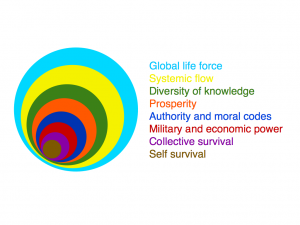
Each scale of individuals and collectives, are reaching, as interested and able, into expanded purposes (Figure C). A range of purposes are alive at every scale, from the individual to the city, to the planet and universe; even purposes we can not yet contemplate and imagine. Each purpose is in response to context and circumstances and are therefore always in flux. As life conditions change, we are pulled down the Spiral to ensure survival, and we are pulled up the Spiral as we aim to improve.
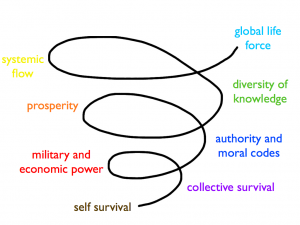
This all takes place as a dance between our individual and collective lives, and especially in the co-creative dance where we built our physical, social and economic habitats together: the city.
A city’s destination is to serve the evolution of our evolving purposes.
What purposes are alive in you? In your city?
What purposes are you and your city expanding into?
_____ _____ _____
This post forms part of Chapter 5 – Destination Alive or Adrift, of Nest City: The Human Drive to Thrive in Cities. Click here for an overview of Chapters 4-7 (Part 2 – Organizing for Emergence). Click here for an overview of the three parts of Nest City.
The Spiral is based on the work of Clare Graves, Don Beck and Christopher Cowan: Spiral Dynamics.
Scales of purposes
The purposes I pursue are informed by what I value. The purposes we pursue are informed by what we value. Purpose and value drives both my decisions and those of the larger wholes of which I am a part.
I am a whole system myself, and I find myself within the larger whole of my family. My family is a system within the larger system of our neighbourhood. My neighbourhood is a system inside the larger system of the city of Edmonton and its region. Edmonton is a system within the larger system of Canada, and Canada a nation of the world. Each system is whole and is also a part of larger wholes. Each system has its respective purpose and set of values, which may be aligned or disparate, but they each are live with purpose.
Each scale will have a purpose that reflects its life conditions. (See Figure B to see the Spiral; here is a primer on Spiral Dynamics.) While I value prosperity and creative entrepreneurship today (with the time I have to write), I recognize that the school and police systems in Edmonton are operating out of authority and moral codes today because of two teens who threatened, online, to hurt many people. Their actions have been taken seriously and they have been charged. Organizations across Edmonton are diving in to make financial contributions to the Edmonton Food Bank to ensure families have enough food this Christmas. They are guided by moral codes to serve folks in survival mode.
And as we gather for upcoming winter festivities, whatever religion, we are engaging in long-held practices that bring communities together to bond for collective survival of culture. Others in my city are working on open data systems that help the city see itself, so we are able to explore more fully the diversity of knowledge at our disposal. Others yet see ways to make all of the above be healthy and vibrant, so we have a city that serves citizens well.

A variety of purposes are alive at every scale, from the individual to the city to the planet and the Universe. Each scale of individuals and collectives, are reaching, as interested and able, into expanded purposes.
What purposes are alive in you? In your city?
What purposes are you and your city expanding into?
_____ _____ _____
This post forms part of Chapter 5 – Destination Alive or Adrift, of Nest City: The Human Drive to Thrive in Cities. Click here for an overview of Chapters 4-7 (Part 2 – Organizing for Emergence). Click here for an overview of the three parts of Nest City.
The Spiral is based on the work of Clare Graves, Don Beck and Christopher Cowan: Spiral Dynamics.


